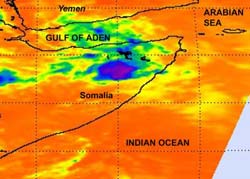Bandu begone: Tropical Cyclone 2A fading in Somalia

On May 22 at 22:29 UTC (6:29 p.m. EDT) NASA\'s Atmospheric Infrared Sounder flying aboard the NASA Aqua satellite captured a small area of cold clouds (blue) associated the remnants of Bandu. Credit: NASA JPL, Ed Olsen<br>
Before 24 hours had elapsed, Bandu had already dissipated because of cooler waters, higher wind shear and drier air in the Gulf of Aden. It curved southwest and made landfall in northeast Somalia. On May 22 at 22:29 UTC (6:29 p.m. EDT) NASA's Atmospheric Infrared Sounder (AIRS) flying aboard the NASA Aqua satellite captured a small area of cold clouds associated the remnants of Bandu. AIRS measures cloud-top temperatures and noticed the remnants over the Sool and Puntland regions of Somalia.
On Monday, May 24, the remnants of Bandu were still bringing showers to northeastern Somalia. Forecasts for the cities of Garowe and Las Anod call for widely scattered showers and thunderstorms with temperatures in the low 80s (Fahrenheit) as Bandu's remnants continue to dissipate. Garowe is the capital city of the Puntland administrative region of Somalia. Las Anod is the administrative capital of Sool region of Somalia.
Media Contact
More Information:
http://www.nasa.govAll latest news from the category: Earth Sciences
Earth Sciences (also referred to as Geosciences), which deals with basic issues surrounding our planet, plays a vital role in the area of energy and raw materials supply.
Earth Sciences comprises subjects such as geology, geography, geological informatics, paleontology, mineralogy, petrography, crystallography, geophysics, geodesy, glaciology, cartography, photogrammetry, meteorology and seismology, early-warning systems, earthquake research and polar research.
Newest articles

Properties of new materials for microchips
… can now be measured well. Reseachers of Delft University of Technology demonstrated measuring performance properties of ultrathin silicon membranes. Making ever smaller and more powerful chips requires new ultrathin…

Floating solar’s potential
… to support sustainable development by addressing climate, water, and energy goals holistically. A new study published this week in Nature Energy raises the potential for floating solar photovoltaics (FPV)…

Skyrmions move at record speeds
… a step towards the computing of the future. An international research team led by scientists from the CNRS1 has discovered that the magnetic nanobubbles2 known as skyrmions can be…




















